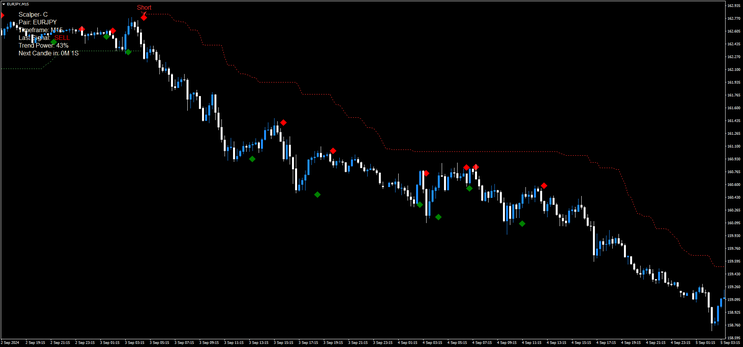55# ATR with Scalper C , Trading System
Submit by Lorentz
This trading strategy is designed for both scalping and day trading on short timeframes (1, 3, and 5 minutes) and longer timeframes (15, 30, and 60 minutes). It uses two indicators: ATR (Average True Range) to measure volatility, and Scalper C (Arrow Trend Momentum). The strategy has specific rules for different timeframes.
Indicators Used
-
ATR (Average True Range):
-
ATR Period: 10
-
ATR Multiplier:
-
1, 3, and 5 minutes = 10
-
15, 30, and 60 minutes = 5
-
-
-
Scalper C (Arrow Trend Momentum):
-
Scalper C Period:
-
3 and 5 minutes = 13
-
15, 30, and 60 minutes = 9
-
-
Timeframe-Specific Settings
-
1-Minute Timeframe:
-
ATR Multiplier: 10
-
ATR Period: 10
-
Entry Rule: Follow the 4-hour (4H) trend.
-
If the 4H trend is up, only look for buy trades.
-
If the 4H trend is down, only look for sell trades.
-
(Use Entry 1 only)
-
-
-
3 and 5-Minute Timeframes:
-
ATR Multiplier: 10
-
ATR Period: 10
-
Scalper C Period: 13.
-
-
Entry Rules:
-
Follow the 4-hour (4H) trend:
-
If the 4H trend is up, only buy.
-
If the 4H trend is down, only sell. (Entry 1)
-
-
Use Scalper C when it aligns with the ATR direction for quick profits. (Entry 2)
-
-
15, 30, and 60-Minute Timeframes:
-
ATR Multiplier: 5
-
ATR Period: 10
-
Scalper C Period: 9
-
Entry Rules:
-
Follow the daily trend:
-
If the daily trend is up, only buy.
-
If the daily trend is down, only sell. (Entry 1)
-
-
Use Scalper C when it aligns with the ATR direction for quick profits. (Entry 2)
-
-
Entry Rules
Entry 1: Follow the Trend with ATR Signals (4H or Daily Trend)
-
Buy Signal:
-
Condition: When price moves above the upper ATR band (calculated using the ATR multiplier), open a Buy position.
-
Stop-Loss: Set below the lower ATR band or at the most recent swing low.
-
Take-Profit: Use either a fixed pip target (based on ATR) or close the trade at the next resistance level.
-
-
Sell Signal:
-
Condition: When price moves below the lower ATR band, open a Sell position.
-
Stop-Loss: Set above the upper ATR band or at the most recent swing high.
-
Take-Profit: Use either a fixed pip target or close the trade at the next support level.
-
Note: For the 1-minute timeframe, only use this ATR-based entry rule.
Entry 2: Scalper C Alignment with ATR (For 3-Minutes and Higher)
-
Buy Signal:
-
Condition: When Scalper C turns bullish (up arrow) and is aligned with the ATR signal (price above the upper ATR band), open a Buy position.
-
Stop-Loss: Place the stop-loss below the lower ATR band or the most recent swing low.
-
Take-Profit: Aim for a few candles or the next key resistance level for quick profit.
-
-
Sell Signal:
-
Condition: When Scalper C turns bearish (down arrow) and aligns with the ATR signal (price below the lower ATR band), open a Sell position.
-
Stop-Loss: Place the stop-loss above the upper ATR band or the most recent swing high.
-
Take-Profit: Aim for a few candles or the next key support level for quick profit.
-
Risk Management
-
Risk per Trade: Limit risk to 1-2% of account capital on each trade.
-
Stop-Loss: Set based on ATR levels or recent highs/lows.
-
Take-Profit: Target a reward-to-risk ratio of 1.5:1 or 2:1, or adjust based on key support/resistance levels.
Additional Guidelines
-
1-Minute Timeframe: Act quickly and only follow the 4H trend using Entry 1. Be mindful of spreads and commissions, which can affect short timeframes.
-
3 and 5-Minute Timeframes: You can use both Entry 1 (4H trend) and Entry 2 (Scalper C alignment). Be quick to exit trades if Scalper C shows signs of reversal.
-
15, 30, and 60-Minute Timeframes: Suitable for both short scalping trades (Entry 2) and longer day trades (Entry 1). The ATR settings are tighter, providing clearer entry and exit points.
By following ATR-based entries and aligning them with Scalper C and higher time frame trends, this strategy offers flexibility across different timeframes, helping you capture both volatility and quick trend reversals efficiently.
Hells Angels - Forex Strategies - Forex Resources - Forex ...
69# THV Cobra with TudorGirl's Sinc Spectrum Cycle - Forex ...
25# EMA's Band Scalp - Forex Strategies - Forex Resources -
98# AFX Trader - Forex Strategies - Forex Resources - Forex ...
77# Stochastic, MA, and MACD Scalping
32# The Secret Method - Forex Strategies - Forex Resources -
71# 5m, The Force - Forex Strategies - Forex Resources - Forex ...
104# Vlad System 15 min Day Trading
102# Scalping Trading System " Predator"
16# Mouteki System - Forex Strategies - Forex Resources - Forex ...
138# 5 min Momo Trader - Forex Strategies - Forex Resources ...
Bullish Reversal Candelstick Pattern - Forex Strategies - Forex ...
19# Action Trade - Forex Strategies - Forex Resources - Forex ...
70# Advanced RSX Scalping Strategy
120# The Secret Method 2.7 - Forex Strategies - Forex Resources











Write a comment
Shail (Monday, 26 January 2015 13:01)
Awesome formula sir, helping a lot. thanks.